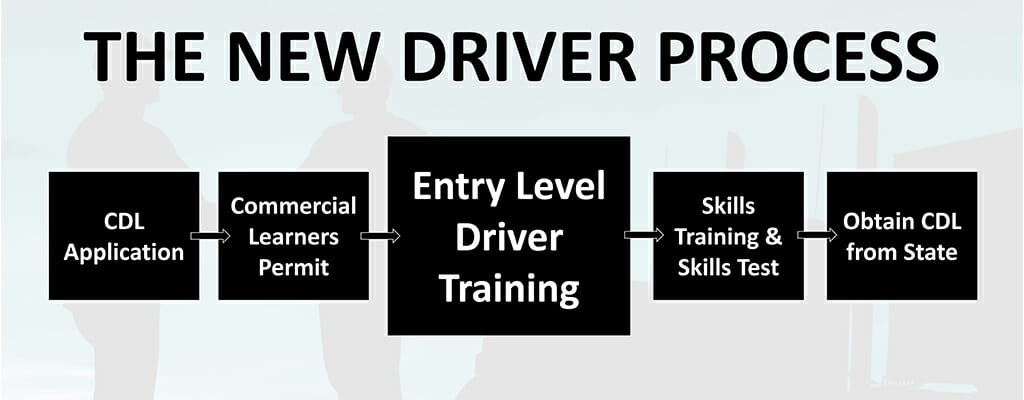How You Can Make New ELDT Mandates Work for You
New ELDT Mandates for the Transportation Industry
The new Entry-Level Driver Training (ELDT) Mandates introduced by the Federal Motor Carrier Safety Administration (FMCSA) in February 2022 have brought significant changes to the transportation industry. These ELDT Mandates establish minimum standards for training new drivers, including both theoretical knowledge and practical behind-the-wheel experience. This comprehensive expansion aims to provide a clear and accurate overview of these mandates, emphasizing key points, main ideas, and additional information about training documentation.
2022 have brought significant changes to the transportation industry. These ELDT Mandates establish minimum standards for training new drivers, including both theoretical knowledge and practical behind-the-wheel experience. This comprehensive expansion aims to provide a clear and accurate overview of these mandates, emphasizing key points, main ideas, and additional information about training documentation.
Key Points of ELDT Mandates:
- Regulatory Changes:
- The FMCSA implemented regulatory changes to entry-level driver training in February 2022.
- These changes aim to enhance the safety and competence of new drivers entering the transportation industry.
- Training Standards:
- The ELDT Mandate sets minimum standards for both theory and behind-the-wheel training.
- Theory training covers essential topics such as vehicle operation, control systems, and basic safety procedures.
- Behind-the-wheel training requires practical driving experience under the supervision of a qualified instructor.
- Training Documentation:
- Accurate documentation is crucial for compliance with ELDT Mandates.
- Training providers must maintain detailed records of each driver’s training progress.
- Documentation should include:
- Dates and duration of training sessions
- Topics covered during theory training
- Performance evaluations during behind-the-wheel training
- Certificates of completion for both theory and practical training
- Training records should be easily accessible for auditing and verification purposes.
- Benefits of ELDT Mandates:
- Improved driver safety and competency
- Standardized training procedures across the industry
- Enhanced compliance with federal regulations
Examples and Practical Implications:
- Example 1: A new driver undergoes theory training on vehicle inspection and learns how to identify potential mechanical issues. This knowledge helps prevent accidents caused by vehicle malfunctions.
- Example 2: During behind-the-wheel training, a driver practices defensive driving techniques, reducing the risk of collisions on the road.
Importance of ELDT Mandates in Driver Training
The ELDT Mandates introduced by the FMCSA in 2022 represent a significant step forward in improving the safety and competency of new drivers in the transportation industry. By establishing minimum standards for theory and behind-the-wheel training, these mandates ensure that drivers are adequately prepared for the challenges of the road. Accurate training documentation is essential for compliance and verification, benefiting both drivers and training providers. Adhering to these mandates ultimately leads to safer roads and a more standardized approach to driver training.
The new ELDT mandates affect all drivers seeking:
- Class A CDL
- Class B CDL
- Upgrade from Class B to Class A CDL
- School (S) Endorsement
- Passenger (P) Endorsement
- Hazardous Material (H) Endorsement
All training must be completed through an organization listed on FMCSA’s Training Provide Registry to count towards their CDL. These new mandates also require that new drivers score at least 80% on their ELDT testing to pass.
What Do These Changes Mean for You?
The implementation of the new ELDT Mandates (Entry-Level Driver Training) presents both challenges and opportunities for your organization. These changes could exacerbate existing difficulties in recruiting drivers, yet they also offer a strategic advantage if leveraged correctly.
Challenges:
- Recruitment Strain: The ELDT Mandates could make it harder to recruit drivers as they would need to meet the new training requirements.
Opportunities:
- Recruitment Tool: By providing the necessary ELDT training in-house, you can attract new drivers who are looking for comprehensive training programs.
Steps to Leverage ELDT Mandates:
- Register with FMCSA: Any organization providing entry-level driver training must register with the Federal Motor Carrier Safety Administration (FMCSA).
- Partner with Registered Providers: If your organization cannot provide the training directly, partner with an already registered company to offer the ELDT curriculum. This allows you to provide necessary training without straining your safety and training programs.
Training Documentation:
- Comprehensive Records: Maintain detailed records of all training activities, including course content, attendance, and performance evaluations.
- Compliance Verification: Ensure that all training documentation meets FMCSA requirements to avoid potential penalties.
- Digital Solutions: Use digital platforms for managing and storing training records, making them easily accessible for audits and internal reviews.
- Regular Updates: Periodically update the training curriculum and documentation to reflect any changes in ELDT mandates or industry standards.
Benefits:
- Competitive Edge: Providing ELDT training online can give your organization a competitive edge in the recruitment market.
- Enhanced Safety: Comprehensive training ensures that new drivers are well-prepared, enhancing overall road safety.
- Regulatory Compliance: Adhering to ELDT mandates helps avoid legal issues and ensures your organization remains in good standing with regulatory bodies.
By understanding and adapting to the ELDT Mandates, your organization can turn potential challenges into strategic opportunities, ensuring both compliance and a robust recruitment pipeline.
Remember, effective management of training documentation is crucial for both compliance and operational efficiency. Keep your records thorough and up-to-date to maximize the benefits of these new mandates.
Incorporating Online Theory Training
Vertical Alliance Group is a registered theory training provider for these nee ELDT mandates. We have training to deal with the required courses, including:
- Basic operation
- Safe operating procedures
- Advanced operating procedures
- Vehicle systems and reporting malfunctions
- Non-driving activities
With our online training system, drivers can complete ELDT curriculum in a fraction of the time it would take to complete in-person training. We can also take care of all required reporting needs to ensure drivers who complete their training get their paperwork in before the deadline.
Using our ELDT program also means you have access to all records associated with your training anytime you need it. You can track new driver progress through the system, and make sure potential new hires are completing their training.
You can incorporate another registered training program for behind the wheel training or set it up in-house to fit your company needs.
Remain Competitive When It Comes to Recruitment
No matter the size of your trucking company, the right training program can give you a competitive edge when it comes to recruitment. Using the Trucking 52 safety training for small fleets program to meet your orientation and ongoing training needs, combined with ELDT theory curriculum, you can provide a robust program that will help you stand out.
Key Points:
- Competitive Edge in Recruitment
- A well-structured training program is crucial for attracting top talent.
- Trucking 52 offers targeted safety training specifically for small fleets.
- Incorporating ELDT theory curriculum ensures compliance with federal requirements and enhances your training offerings.
- Benefits of Trucking 52 Safety Training
- Orientation and Ongoing Training: Trucking 52 covers both initial and continuous training needs.
- Customizable Modules: Tailor the program to fit the specific needs of your fleet.
- User-Friendly Interface: Easy for both trainers and trainees to navigate.
- ELDT Mandates
- Compliance: Ensuring your training program meets ELDT Mandates is essential for legal compliance and operational efficiency.
- Theory Curriculum: Trucking 52 integrates ELDT theory curriculum, helping you stay compliant with the latest federal mandates.
- Documentation: Keep thorough records of all training activities to easily demonstrate compliance with ELDT mandates.
How Training Can Increase Recruitment and Retention
- Improved Skills: Comprehensive training improves driver skills, making them more efficient and safer on the road.
- Job Satisfaction: Drivers who receive thorough training are more likely to feel confident and satisfied with their jobs, leading to higher retention rates.
- Reputation: A strong training program can enhance your company’s reputation as a desirable place to work.
Request a Demo
Want to see for yourself how training can increase your driver recruitment and retention? Request a demo of Trucking 52 for a look at our online training program. If you’re interested in the ELDT curriculum, you can request a demo of our ELDT curriculum management system too.
Additional Information
- Training Documentation: Maintain detailed records of all training sessions, materials used, and assessments conducted. This documentation is vital for:
- Compliance Audits: Easily demonstrate adherence to ELDT mandates.
- Performance Tracking: Monitor driver progress and identify areas for improvement.
- Continuous Improvement: Use feedback from training sessions to continually enhance your program.
By leveraging the Trucking 52 program and adhering to ELDT Mandates, your trucking company can not only meet regulatory requirements but also create a robust training environment that attracts and retains top talent.
FAQs
What are ELDT Mandates?
ELDT Mandates, or Entry-Level Driver Training Mandates, are regulations introduced by the Federal Motor Carrier Safety Administration (FMCSA) in February 2022. These mandates establish minimum training standards for new drivers, ensuring they receive both theoretical knowledge and practical behind-the-wheel experience. The goal is to enhance the safety and competence of drivers entering the transportation industry.
When were the ELDT Mandates implemented?
The ELDT Mandates were officially implemented by the FMCSA in February 2022. This marked a significant change in the regulatory landscape for the transportation industry, aiming to standardize the training process for entry-level drivers and improve overall road safety.
Why were the ELDT Mandates introduced?
The ELDT Mandates were introduced to address the need for improved safety and competence among new drivers. By setting minimum training standards, the FMCSA aims to ensure that all entry-level drivers are adequately prepared for the challenges of the road, thereby reducing accidents and enhancing overall safety in the transportation industry.
What are the key components of ELDT training?
Key components of ELDT training include both theory and practical elements. Theory training covers essential topics such as vehicle operation, control systems, and basic safety procedures. Behind-the-wheel training provides practical driving experience under the supervision of a qualified instructor, ensuring that drivers can apply their theoretical knowledge in real-world scenarios.
What documentation is required under ELDT Mandates?
Under the ELDT Mandates, training providers must maintain detailed records of each driver’s training progress. This documentation should include the dates and duration of training sessions, topics covered during theory training, performance evaluations during behind-the-wheel training, and certificates of completion for both theory and practical training. Accurate documentation is crucial for compliance and auditing purposes.
How do ELDT Mandates benefit the transportation industry?
ELDT Mandates benefit the transportation industry by improving driver safety and competency. They standardize training procedures across the industry, ensuring that all new drivers meet a minimum level of competence. Additionally, these mandates enhance compliance with federal regulations, helping to create a more uniform and safer transportation environment.
What types of CDL and endorsements do ELDT Mandates affect?
ELDT Mandates affect drivers seeking Class A CDL, Class B CDL, upgrading from Class B to Class A CDL, and those seeking specific endorsements such as School (S), Passenger (P), and Hazardous Material (H) endorsements. These mandates ensure that all drivers, regardless of the type of CDL or endorsement, receive comprehensive and standardized training.
What is the minimum passing score for ELDT testing?
To comply with ELDT Mandates, new drivers must score at least 80% on their ELDT testing to pass. This passing score ensures that drivers have adequately absorbed the theoretical knowledge and are prepared to apply it in practical driving scenarios.
What challenges do ELDT Mandates present?
ELDT Mandates present several challenges, particularly in terms of recruitment. The new training requirements may make it harder to recruit drivers, as they must meet these stringent standards before being eligible for a CDL. This could exacerbate existing difficulties in finding qualified drivers in the transportation industry.
How can organizations leverage ELDT Mandates for recruitment?
Organizations can turn the challenges of ELDT Mandates into opportunities by providing the necessary ELDT training in-house. By doing so, they can attract new drivers who are looking for comprehensive training programs. Additionally, organizations can partner with registered training providers to offer the ELDT curriculum, ensuring they meet all regulatory requirements while appealing to prospective drivers.
What steps should organizations take to comply with ELDT Mandates?
To comply with ELDT Mandates, organizations should first register with the FMCSA as a training provider. If they cannot provide the training directly, they should partner with an already registered provider. Organizations must also maintain detailed training records, ensure all documentation meets FMCSA requirements, and periodically update their training curriculum to reflect any changes in the mandates or industry standards.
How can digital solutions help with ELDT compliance?
Digital solutions can greatly assist with ELDT compliance by managing and storing training records in an organized and easily accessible manner. Digital platforms make it easier to track and audit training activities, ensuring that all documentation is up-to-date and meets FMCSA requirements. This can save time and reduce the administrative burden associated with compliance.
What are the benefits of providing ELDT training in-house?
Providing ELDT training in-house offers several benefits. It can give organizations a competitive edge in recruitment by offering a comprehensive training program that meets federal standards. In-house training also ensures that new drivers are well-prepared and competent, enhancing overall road safety. Additionally, it allows organizations to maintain better control over the training process and ensure compliance with ELDT Mandates.
How does online theory training fit into ELDT Mandates?
Online theory training is an effective way to meet the requirements of ELDT Mandates. It allows drivers to complete the theoretical portion of their training more efficiently than traditional in-person methods. Online training systems can provide the necessary course content and assessments, ensuring that drivers meet the required standards and deadlines for theory training.
What should be included in training documentation for ELDT compliance?
Training documentation for ELDT compliance should be comprehensive and detailed. It should include course content, attendance records, performance evaluations, and certificates of completion. Additionally, documentation should be regularly updated to reflect any changes in ELDT Mandates or industry standards. Accurate and thorough documentation is essential for demonstrating compliance during audits and reviews.
How do ELDT Mandates impact driver retention?
ELDT Mandates can positively impact driver retention by ensuring that drivers receive thorough and comprehensive training. Well-trained drivers are more likely to feel confident and satisfied with their jobs, leading to higher retention rates. Moreover, a strong training program can enhance the company’s reputation as a desirable place to work, attracting and retaining top talent in the industry.












